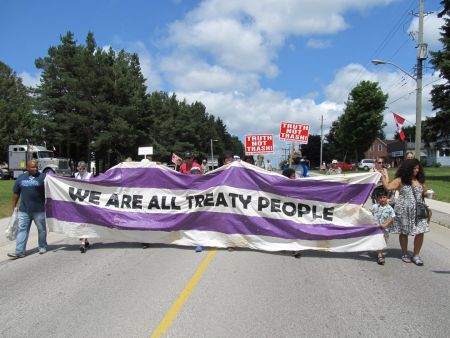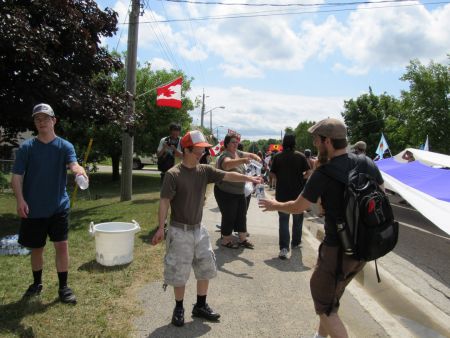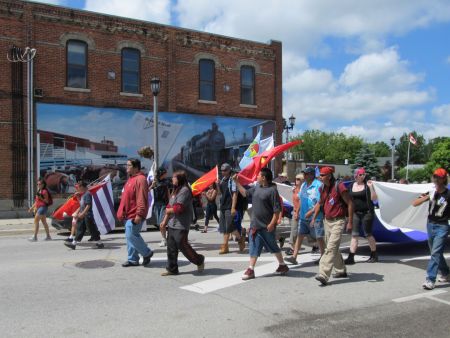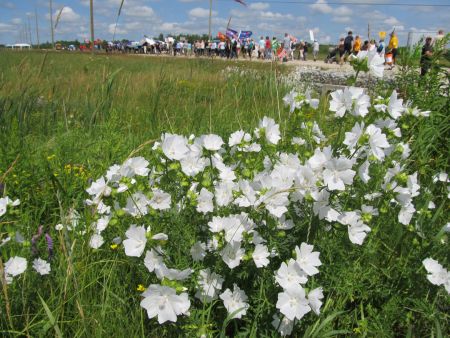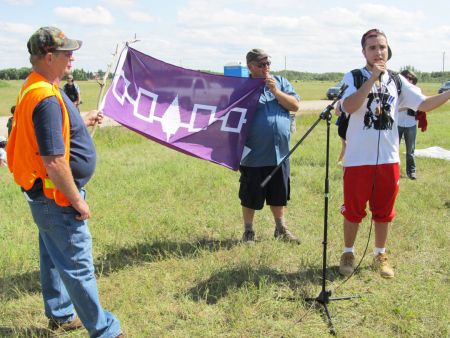Story and photos by Deb O'Rourke, Video Shot & Cut by Darryl Richardson & Zach Ruiter
July 7, 2012: Dundalk, ON.
Toronto’s crap may soon be coming to Dundalk.
But not if a coalition of concerned Dundalk citizens, Six Nations land
defenders and supporters, and shamed Torontonians have anything to say
about it. With the blessings of Southgate Council, which governs the
verdant plateau where Dundalk sits, Ontario’s Lystek International Inc.
has broken ground on the creation of an “Eco-Park” facility to make
big-city offal a little less awful, then make additional cash by selling
it to farmers for fertilizer.
“We found that Eco-Park doesn’t mean what you’d think it means,” said a
Dundalk citizen who welcomed the supporters from Six Nations, Toronto and
Kitchener-Waterloo who poured from three school busses. “It means the
opposite.”
It’s a good idea to do constructive things with organic waste. But the
stuff that flows through city sewers is not exactly black gold: it
contains the leavings of every industrial and urban activity including
medical, manufacturing and auto waste. And it definitely has a smell. It’s
not a NIMBY thing to keep “eco-parks” at a far remove from the places
where kids spend their days. School’s tough enough on a good day in a
sweet wind. If the sludge facility operates as proposed, 350 meters from
the Dundalk and Proton elementary school, it would be hell.
The green of fields and forests isn’t just a colour. It’s the most subtle,
sweet and vital factory on earth: making complex food molecules from sun,
water and a few elements: a process that marries sky and earth. Poo
retains a lot of those elements and in balanced conditions is a resource
for plants. But cultures that last more than a few centuries (look to the
Haudenosaunee at Six Nations) know that you have to be careful where you
put it. If you want the water and food supply to last much beyond the next
quarterly report, you put the waste closer to the end of something than to
the beginning of something. You put it where it’s needed, and has time and
space to become what poo ought to become. You don’t put it on a plateau
that frequently floods (earning the township the nickname of Floatin’
Proton) then absorbs and filters the waters that become the Grand and
Saugeen Rivers.
So, as I dismount from the bus, I find myself saying to locals: “Sorry
about my sludge.”
The gentle people who greet us politely suggest that I keep my gift to the
earth where I can personally enjoy its dubious benefits. If Toronto’s
waste can’t be processed and used within its limits, the technology is
certainly not at a stage where it can be laid out in this sweet air, on
this sweet foodland.
Ruby Montour of Six Nations didn’t mince words when she assured Dundalk
residents of Six Nations support in resisting a project that has
implications for the water and food supply of one of the most fertile
areas of Canada.
“It’s horrible and you don’t deserve it,” she told residents of this
farming community. “Your lives are important. Your children are important.
Your futures are important.”
The Dundalk community is new at this demonstration stuff. They are still
press-shy, but welcomed the diverse souls who came to walk with them and
to learn about their community. The contingent carried a giant flag of the
2-Row wampum, the earliest and foundational agreement between European and
Haudenosaunee nations, where the nations vowed to travel in parallel, not
interfering with one another but co-existing in a spirit of peace,
friendship and respect. The town was quiet, and marchers were met with
bemusement and warmth.
Reflecting the closed, rushed process that residents say led to the
Southgate Council’s agreement to host the waste facility, lawns sported
“Truth not Trash” signs. To those who had also walked with Six Nations in
Caledonia on April 28, it was a welcome change to get the thumbs-up in
Dundalk instead of the shouts to “Go home!” that greeted us in Caledonia.
One household gave out cold water to thirsty walkers.
A picnic across from the Eco-Park further cemented relations between
Dundalk and Six Nations folk. Making a gift of the Haudenosaunee flag at
the request of a Dundalk community member, John Henhawke gave a very brief
account of the history this flag embodies, of how five and then six
conflicting nations created a peace, to form the Haudenosaunee
Confederacy. This was an extraordinary gift: for the Haudenosaunee are
very careful to ensure that those who fly their flag are respectful, and
allied to their causes.
Dundalk residents who are taking the issue to court and who, with the help
of Six Nations, have been barricading the road to the Eco-Park, learned
that Six Nations will be using the1701 Nanfan treaty, the UN Declaration
on Rights of Indigenous Peoples, and the 1784 Haldimand Proclamation to
help fight this battle.
Speakers from the Six Nations Men’s Fire pointed out: “This is two-row in
action: we’re working together.” They admonished: “Even we as Onkwehonwe
people, we can never own that land. You can never own it. But we can all
be stewards of the land, take care of it the best we can.”
